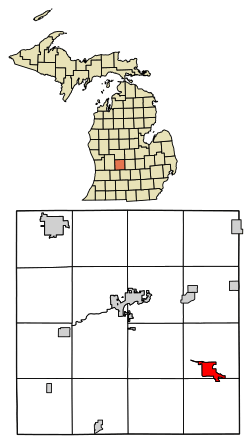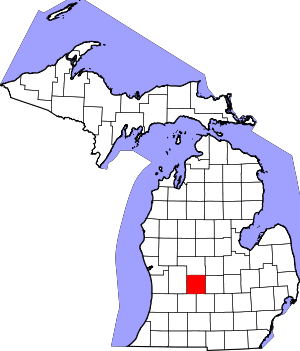Portland, Michigan
Portland is a city in Ionia County of the U.S. state of Michigan. The population was 3,883 at the 2010 census. The city is situated in the south central portion of Portland Township and is known as the "City of Two Rivers" since it is the confluence of the Grand River and the Looking Glass River. Portland is home to Portland Public Schools and Portland Saint Patrick Catholic School and has been a Main Street Community since 2003.
Portland, Michigan | |
|---|---|
| Nickname(s): City of Two Rivers | |
 Location of Portland, Michigan | |
| Coordinates: 42°52′5″N 84°54′11″W | |
| Country | United States |
| State | Michigan |
| County | Ionia |
| Area | |
| • Total | 2.77 sq mi (7.18 km2) |
| • Land | 2.63 sq mi (6.81 km2) |
| • Water | 0.14 sq mi (0.37 km2) |
| Elevation | 725 ft (221 m) |
| Population | |
| • Total | 3,883 |
| • Estimate (2019)[3] | 3,948 |
| • Density | 1,501.71/sq mi (579.73/km2) |
| Time zone | UTC-5 (Eastern (EST)) |
| • Summer (DST) | UTC-4 (EDT) |
| ZIP code | 48875 |
| Area code(s) | 517 |
| FIPS code | 26-65860[4] |
| GNIS feature ID | 0635311[5] |
| Website | www |
History
According to government records, the first land that was owned in what is now known as Portland was owned by Elisha Newman in 1833. The first post office arrived in 1837.[6] Portland has been home to several Native American tribes, and was the dwelling-place of John Okemos in the 1850s.
The first train arrived in Portland in 1869.[7] Portland's growth in population led to becoming a Village in 1869 and a City in 1969.[8]
Geography
According to the United States Census Bureau, the city has a total area of 2.78 square miles (7.20 km2), of which 2.64 square miles (6.84 km2) is land and 0.14 square miles (0.36 km2) is water.[9]
Demographics
| Historical population | |||
|---|---|---|---|
| Census | Pop. | %± | |
| 1870 | 1,060 | — | |
| 1880 | 1,670 | 57.5% | |
| 1890 | 1,678 | 0.5% | |
| 1900 | 1,874 | 11.7% | |
| 1910 | 1,832 | −2.2% | |
| 1920 | 1,899 | 3.7% | |
| 1930 | 1,902 | 0.2% | |
| 1940 | 2,247 | 18.1% | |
| 1950 | 2,807 | 24.9% | |
| 1960 | 3,330 | 18.6% | |
| 1970 | 3,817 | 14.6% | |
| 1980 | 3,963 | 3.8% | |
| 1990 | 3,889 | −1.9% | |
| 2000 | 3,789 | −2.6% | |
| 2010 | 3,883 | 2.5% | |
| Est. 2019 | 3,948 | [3] | 1.7% |
| U.S. Decennial Census[10] | |||
2010 census
As of the census[2] of 2010, there were 3,883 people, 1,640 households, and 1,039 families residing in the city. The population density was 1,470.8 inhabitants per square mile (567.9/km2). There were 1,797 housing units at an average density of 680.7 per square mile (262.8/km2). The racial makeup of the city was 96.7% White, 0.7% African American, 0.4% Native American, 0.2% Asian, 0.6% from other races, and 1.4% from two or more races. Hispanic or Latino of any race were 3.1% of the population.
There were 1,640 households, of which 33.2% had children under the age of 18 living with them, 46.1% were married couples living together, 12.1% had a female householder with no husband present, 5.2% had a male householder with no wife present, and 36.6% were non-families. 31.7% of all households were made up of individuals, and 11.9% had someone living alone who was 65 years of age or older. The average household size was 2.37 and the average family size was 2.98.
The median age in the city was 35.6 years. 25.4% of residents were under the age of 18; 9% were between the ages of 18 and 24; 27.8% were from 25 to 44; 25% were from 45 to 64; and 13% were 65 years of age or older. The gender makeup of the city was 49.0% male and 51.0% female.
2000 census

As of the census[4] of 2000, there were 3,789 people, 1,507 households, and 1,054 families residing in the city. The population density was 1,577.7 per square mile (609.6/km2). There were 1,574 housing units at an average density of 655.4 per square mile (253.2/km2). The racial makeup of the city was 97.68% White, 0.50% African American, 0.24% Native American, 0.18% Asian, 0.34% from other races, and 1.06% from two or more races. Hispanic or Latino of any race were 1.32% of the population.
There were 1,507 households, out of which 36.2% had children under the age of 18 living with them, 54.7% were married couples living together, 11.9% had a female householder with no husband present, and 30.0% were non-families. 26.9% of all households were made up of individuals, and 12.6% had someone living alone who was 65 years of age or older. The average household size was 2.51 and the average family size was 3.05.
In the city, the population was spread out, with 28.8% under the age of 18, 7.5% from 18 to 24, 30.5% from 25 to 44, 20.5% from 45 to 64, and 12.7% who were 65 years of age or older. The median age was 34 years. For every 100 females, there were 89.3 males. For every 100 females age 18 and over, there were 87.2 males.
The median income for a household in the city was $45,656, and the median income for a family was $57,875. Males had a median income of $39,344 versus $30,348 for females. The per capita income for the city was $20,028. About 5.7% of families and 6.6% of the population were below the poverty line, including 9.1% of those under age 18 and 5.4% of those age 65 or over.
Government
Portland is a council-manager government, in which the city council appoints one of its members as mayor and another as mayor pro tem — a city council member with extra ceremonial duties who chairs council meetings in the mayor's absence. The city council consists of 5 at-large council members who are elected in non-partisan elections. The registered voters of the City of Portland elect all members for either a 4-year term or a 2-year term. The elections are held in November of the odd year. The city council appoints the city manager, the city's chief administrative officer.[11] The city levies an income tax of 1 percent on residents and 0.5 percent on nonresidents. [12]
References
- "2019 U.S. Gazetteer Files". United States Census Bureau. Retrieved July 25, 2020.
- "U.S. Census website". United States Census Bureau. Retrieved 2012-11-25.
- "Population and Housing Unit Estimates". United States Census Bureau. May 24, 2020. Retrieved May 27, 2020.
- "U.S. Census website". United States Census Bureau. Retrieved 2008-01-31.
- U.S. Geological Survey Geographic Names Information System: Portland, Michigan
- Rice, Mrs. N. B. Early History of Portland, Michigan.
- "Portland | Michigan History". michiganhistory.leadr.msu.edu. Retrieved 2015-12-09.
- Portland Sesquicentennial 1869-2019, accessed 30 June 2019.
- "US Gazetteer files 2010". United States Census Bureau. Archived from the original on 2012-07-02. Retrieved 2012-11-25.
- "Census of Population and Housing". Census.gov. Retrieved June 4, 2015.
- "Mayor & City Council". Portland, MI - Official Website. Retrieved 2015-11-02.
- Gibbons, Lauren (August 16, 2017). "Michigan State University, city of East Lansing at odds over proposed income tax". MLive Lansing. Mlive Media Group. Retrieved August 16, 2017.
External links
| Wikimedia Commons has media related to Portland, Michigan. |
